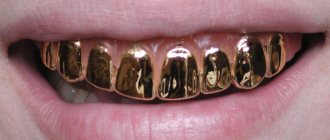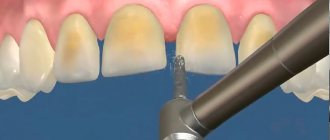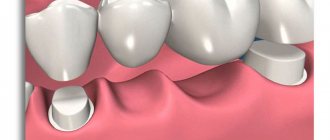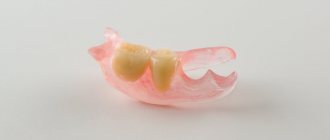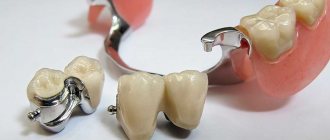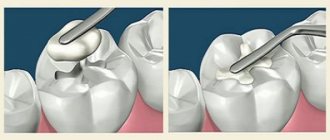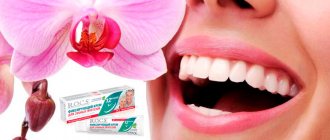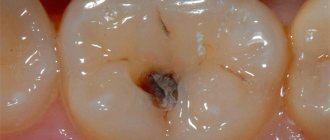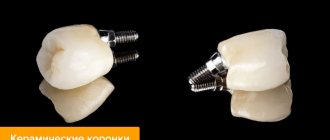Temporary fixation technology
At the preparatory stage, the surgical field and orthopedic structures that are to be fixed are dried and isolated from saliva. Degreasing of working surfaces is not required. Temporary cement is mixed taking into account the manufacturer's recommendations. In the future, the fixation technique - using the example of temporary acrylic crowns on eugenol-free cement - looks like this.
- Temporary cement is applied with a spatula to the cervical part of the temporary crown.
- Under bite control in habitual or central occlusion, the orthopedic structure is fixed in the oral cavity.
- After the time specified by the manufacturer, the temporary cement is removed.
- If work is carried out in support of a dental implant, a rubber dam is used to protect the latter.
- The final stage is x-ray control to check the effectiveness of cement removal.
- Fixation is completed by control of occlusal contacts.
- The patient receives recommendations on the rules for caring for the structure (they are practically no different from the case of installing fixed structures on permanent cement, with the exception of replacing dental floss with a dental brush).
Metal-ceramic crown
Modern materials used to make crowns are extremely durable and resistant to dyes. They are quite smooth and non-porous, so pigments cannot penetrate their structure. This is what allows you to limit yourself to daily oral hygiene using a toothbrush and regular paste.
If the material does darken, it is unlikely to be bleached. Metal-ceramics is a very hard and dense material in its structure; none of the modern brightening agents is able to penetrate inside it. In this case, it is possible to talk only about slight lightening, but not about whitening by several tones.
If the crowns are located on the side of the chewing teeth, then nothing will hinder the whitening of the smile area. Moreover, even a strong difference in shades will not affect the patient’s appearance in any way, because others simply will not notice it.
Operational characteristics
The degree of fixation depends on the characteristics of the temporary cement. One of its important properties is the retention force, which allows you to hold the structure and remove it if necessary. The optimal characteristics of temporary cements include:
- good adhesion of indirect restoration;
- ease of mixing and application;
- ease of removal after fixation of cement residues from prepared structures and outer surfaces of the crown;
- adequate working hours;
- optimal viscosity for comfortable use;
- easy removal of the structure without damaging nearby tissues;
- biocompatibility with abutment tooth structures and soft tissues;
- long shelf life;
- no effect on the adhesion of permanent cement.
To identify and remove excess cement, it must be radiopaque. Today, none of the temporary cements on the market have absolutely all of the above properties. It is advisable to use each of them for a specific purpose due to the lack of a single universal solution.
Ultrasonic cleaning of the oral cavity and results
You can lighten artificial dentures a little and restore the attractiveness of your smile with the help of professional cleaning. The whole point of this method is to eliminate plaque, tartar, food particles and deposits that have accumulated on the surface. Currently, specialists use a variety of methods for processing enamel; ultrasonic scalers are in great demand.
This method involves the use of a special device through the tip of which ultrasound and microvibrations are applied. They are capable of destroying even the hardest plaque in just a few seconds without much effort. Simultaneously with ultrasound, the device delivers a stream of water, due to which the enamel is protected from overheating, and crushed particles of contaminants are washed out from its surface.
Dental clinic specialists strongly recommend cleaning your mouth at least once every six months; this will protect the enamel from the accumulation of hard stone and preserve the health of your teeth for a long time. However, this procedure is also ineffective in whitening fillings and crowns.
Complications
Due to temporary fixation, the following complications are possible:
- de-cementing;
- damage to the supporting structure;
- breakage of the orthopedic structure during removal;
- development of gingivitis or peri-implantitis due to insufficient removal of temporary cement from the gingival sulcus.
The most severe complication is peri-implantitis, in the event of which it is necessary to remove the structure as quickly as possible, remove excess cement and carry out anti-inflammatory measures.
Breakage of the prosthesis or supporting structures is possible due to too much retention force of the temporary cement. Most often, temporary crowns made of plastic or composite materials break. Correcting the situation is quite simple - the damage is glued together with plastic or composite right in the office.
When permanent structures are removed, the ceramic veneer often chips, which requires the manufacture of a new denture. Therefore, it is undesirable to fix ceramic or metal-ceramic prostheses with temporary cement. The least common cases in orthopedic dentistry are cases of breakage or fracture of the crown of a tooth and other damage to supporting structures. Also considered quite rare is the case of excessive load on the implant with the development of peri-implantitis.
What is Dental Crown Adhesive?
When a tooth structure is damaged, the orthopedic dentist grinds down its surface, creates an impression of the jaw and makes a customized partial denture - a crown. It is a cap that is placed on the treated remaining tooth. This event restores the dentition and returns the aesthetic appearance of the smile.
To secure the crown, a composition that acts as composite cement is used. It ensures a tight fit of the artificial material to the tooth tissue and firmly fixes it.
The strength of the adhesive increases after it hardens. A person can even eat solid food, brush their teeth, talk, and the crown will remain in place.
Everything you need to know about temporary crowns
If you follow the recommendations of a specialist, the structure will last 5-7 years. But, there are cases when the installed prosthesis remains throughout life.
However, excessive loads can damage the most expensive and durable cements, and the crown falls out. In such a situation, there is a need for re-fixation, and if it is not possible to immediately go to the dental office, you can purchase special glue for crowns at the pharmacy.
Cement for crowns: types and application features
Most patients who decide on permanent prosthetics do not even suspect that cement is not the only one used for fixing crowns. There are many different options, each of which is optimal in one situation or another. Naturally, the final decision is made by the dentist, but it would also be useful for patients to learn how each type of cement differs and when its use is most appropriate.
- Types of cement for fixing crowns
- How to choose the best cement for crowns
- Zinc phosphate cement for fixation of crowns
- Polycarboxylate cement for crowns
- Glass ionomer cement for fixation of crowns
- Composite cement for crowns
- Polymer modified glass ionomer cement for fixation of crowns
- Video about cement for crowns
What is a crown and when is it installed?
A crown is a single dental prosthesis that completely replicates the visible part of the tooth. This differs from an inlay or veneer, which imitate only a fragment of a tooth. Installation of a crown is required in case of significant damage to the tooth (30% or more), when classical filling is unable to ensure proper functionality of the dental unit. A crown is also placed when a tooth is lost. In this case, the support for the prosthesis is provided by neighboring teeth or an implant that replaces the root of the lost tooth. Depending on the design features, the method of attaching the crown is selected.
Three ways to attach crowns or dentures during implantation
- Cement - attachment to the abutment is performed using composite glue. It has good shock-absorbing properties. The most common type of fixation, which simplifies the installation of a bridge consisting of several elements.
- Screw - the crown is secured to the abutment outside the oral cavity. The resulting structure must be screwed into the implant. A technological hole is used through which a screw is screwed. To disguise it, a composite material is used.
- Telescopic - involves the use of double crowns: one is fixed to the abutment, the other is mounted into the body of the prosthesis.
Description
Fuji 1 (Fuji I) is the first choice material for everyday practice. For more than thirty years, it has been used by dentists all over the world for fixing orthopedic structures made of any metal dental alloys.
Indications
Fuji 1 (Fuji I) is intended for permanent cementation of metal frames of orthopedic structures: bridges, crowns, inlays, onlays, pins, as well as for cementing crowns on implant abutments.
Advantages:
- True chemical adhesion to tooth structures and metals. Does not require special surface preparation or the use of adhesive systems.
- Not afraid of moisture when used. Subsequently, low solubility in oral fluid ensures reliable marginal seal.
- Rubber-like consistency for easy removal of excess.
- No resin content in cement - which is important when working with patients allergic to methacrylates.
- Compatible with pulp and soft tissue, the risk of postoperative hypersensitivity is minimal.
- Constant release of fluoride.
- Pronounced radiopacity
Instructions for use
1. Tooth preparation
Prepare the tooth using standard technique. Use calcium hydroxide to protect the pulp. Clean the stump with pumice and water. Rinse and dry with light air. Do not over-dry or remove the smear layer for better adhesion.
2. Preparing the restoration
Ensure that the orthopedic device is processed and prepared in accordance with the manufacturer's instructions
3. Preparation for mixing
Place one portion of powder (1.8 g) and two drops of liquid (1 g) on the mixing block.
4. Kneading
Mix the powder and liquid for 20 seconds with a plastic spatula. When preparing a large amount of material, divide the powder into two equal parts and add one part to the liquid. Stir for five seconds. Then, add the remaining powder and stir for another 15 seconds. The total preparation time for the mass is 20 seconds. Apply the mixed material with a spatula onto the tooth stump.
5. Fixation technique
Fill the inner surface of the crown with a sufficient layer of cement and immediately begin fixation. Apply moderate pressure and secure the crown for thirty seconds. Excess cement is removed during the rubber-like curing stage.
After 4 minutes 30 seconds after the start of fixation, finishing can be done.
To protect the glass ionomer cement for the next 24 hours, Fudji Kout L Si or Fudji Varniπ varnish should be applied to the edge of the restoration.
Special instructions:
- Mixing time: 2 minutes
- Working time (from start of mixing): 2 minutes
- Finishing start time (after fitting the structure): 4 minutes 30 seconds.
Storage
Store in a dark and cool place at a temperature of 4 to 25 o C.
Authentication
Our online store contains only genuine GC products. Each package of Fuji 1 (Fuji I) has a sticker attached.
To make sure you have an original Fuji I product, do the following:
- Erase the protective layer from the “verification code” field. Below it you will find a unique product code.
- Enter the received code into the form
- Fill out the remaining fields of the form following the instructions on the website.
- Click “check”.
- The test result will appear on the screen.
GC Corporation is the largest dental company specializing in the production and sale of medical dental equipment and materials. GC products are in demand in more than one hundred countries around the world. The main office of GC Corporation is located in Tokyo (Japan). Very soon the company will celebrate its centenary.
Nika Dent is the official dealer of GC Corporation in Russia
Nika Dent is your reliable supplier of dental materials with fast delivery and quality service.
In what cases is it advisable to install on cement?
- Complete, partial edentia;
- single restoration;
- angulation of implants, during which high aesthetic and functional indicators become impossible;
- several designs with non-parallel mesio-distal or vestibulo-lingual angulation;
- the patient's desire to choose this method himself.
Cement fixation is possible:
- with a height of the upper part of the abutment of 5 mm or more;
- when the height of the attached gum around the structure is at least 3-5 mm;
- if the bone wall volume around the implant neck is at least 2-2.5 mm;
- with a crown-to-body height ratio of at least 1:1.5;
- antagonist teeth are in the correct position.
Disadvantages of screw fixation
Despite many positive characteristics, screw fixation of crowns is not without disadvantages:
- The presence of a hole for a screw on the chewing surface of the tooth, if the composite material is incorrectly selected, creates an aesthetic defect. This is a conditional disadvantage, because the defect is covered with a composite material;
- Possibility of loosening the screw and causing mobility of the crown and abutment. If the patient does not contact the dentist in time for correction, peri-implantitis may develop. This also means that you need to be even more responsible when it comes to periodic dental checkups;
- When the screw is loosened, there is also a risk of its fracture (if the patient ignores the occurrence of crown mobility for a long time). It is very difficult to remove a broken screw; this situation becomes the reason for removal of the implant;
- The complexity and complexity of fitting elements of a screw structure. To install a crown using the screw fixation method, a highly qualified doctor is required. The dentist must also have a special key to adjust the force he applies when screwing in the screw in order to avoid mechanical stress in the structure;
- High price. The complexity of manufacturing and installing crowns causes higher prices for the use of screw fixation compared to cement.
Prevention
To ensure that fillings and crowns do not change their color or lose their attractiveness over time, it is very important to properly care for them. Care involves daily oral hygiene (morning, evening, and after each meal). It is also very important to remember to visit your dentist regularly for checkups.
In addition to the timely detection of enamel and gum diseases, the doctor can carry out preventive cleaning. If a patient has a bridge installed in their mouth, they should rinse the area between the crown and the gum tissue as often as possible. In this case, you can use a device such as an irrigator.
Other recommendations include abstaining from eating solid and coloring foods, strong coffee and black tea, red wine, quitting smoking and other bad habits. It is important to avoid strong temperature changes, as this can lead to loosening of the material and its darkening in the future.
previous post
Is it possible to treat teeth with stomatitis?
next entry
Tips for using temporary crowns
- Some foods will stick to the temporary crown, so please avoid chewing gum or other sweets and foods.
- Avoid chewing on the side of your jaw where the temporary crown was placed.
- Try to minimize your consumption of hard foods (such as vegetables), which can break the crown.
- Temporary crowns do not last long. Sometimes they may crack, break or fall out. If this happens to you, please contact us immediately, bring the crown with you, we will reinstall it or replace it.
- Do not remove the temporary crown from your mouth. Without it, your teeth may shift and the target crown may not fit.
- Don't brush too hard on a tooth with a temporary crown, and be careful with floss.
